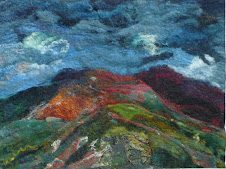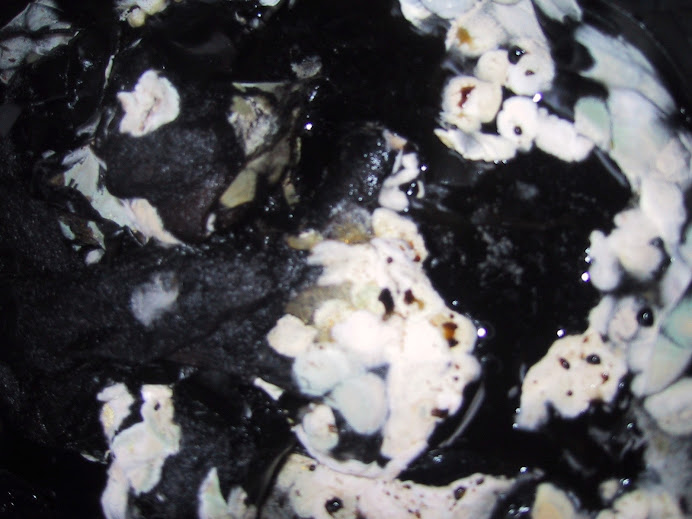We have had, so far, a very mild winter and as I wandered around the dye garden on a very mild sunny day I was astonished at how many dye plants were either still in flower or doing well.
So:
 |
| Chinese Woad Isatis indigotica |
I decided to dye with them all:
starting with Chinese Woad ( Isatis indigotica) .This was last picked in November so all this growth has been since then so I was not sure how much blue there would be in the leaves .
 |
| ripped leaves covered with boiling water |
I picked all the leaves, weighing 220 g and ripped them all roughly , poured over 2 kettlesful of boiling water and left to steep. You can see the colour after about 20 minutes, this is the precursor to Indigotin.
Then I added 1 tablespoon of washing soda ( sodium carbonate)You can see that the water is now a murky green
 |
| Ready to beat |
 |
| starting to beat |
 |
| after beating for a few minutes |
Then I started to beat to areate the liquid . This converts the precursor to indigotin to indigotin which being insoluble will precipitate out. You usually but not aways will see the froth turning blue . It doe slook bluey here but not marketedly so.
 |
| After beating. Now there is blue skim of indigotin on the surface. Hopeful! |
Then I added 1 dessert spoon of thiourea dioxide which removed the oxygen so that the insoluble blue indigotin would convert to its soluble form indigo white. At the sme time I heated the little vat till it was 50 degrees C -the optimum temperature for dyeing wool . The pH was 9.
In the picture below you can see the fully reduced vat with some pale blue undissolved indigo on the surface showing that there is some blue but perhaps not a lot.
 |
| redcuced vat |
 |
| warmed vat with fibres added |
I enterd about 50 g of dry 18,5 micron merino and silk. Here you can see it soaking in the vat.
 |
| fires goingblue in the air |
Here the fibres are hung to drip and
oxidise from yellow to blue.
 |
| weld dyed merino and silk |
I tried dipping the fibre again to get a deeper blue but there was little change in the colour so then I put in some weld dyed fibres - dyed with the weld I found growing in Conwy in November
Here is the result. About 80g of dyed fibres. Not as much as you would probably get if the leaves had growing durign sunny months but still nice to have especially in the bleak winter landscapes with grey skies and drizzling rain.
The rest of the dyes are cooking as I write.





































love the colour you got from the weld & woad...
ReplyDeleteHelen, thank you so much for describing what you do and posting all the pictures! This is so interesting and informative.
ReplyDeleteHi Trica is is great isen't it? I love it too. :) Thanks LAdka -it is good to know others appreciate it .
ReplyDeleteMy woad plants are still flourishing too. It seems strange at this time of year. Love the results you got.
ReplyDeleteHi Claire I agree it does seem odd. Glad you liked the colours. More on the way :) Helen
ReplyDeleteThank you Helen for sharing pics and information how you dyed with woad! I grew a couple of plants this year for the first time and the first dye bath was a disaster. But I didn't lose faith and froze the woad leaves I cut two weeks ago (no time to dye before Christmas). This time I will follow your directions - wish me luck! Greetings from Germany Isabella
ReplyDeleteHi Isabella I really hope it works for you this time . Dolet me know how you get on. Why was the fisst one a disaster? What happened?
ReplyDeleteHi Helen, thank you for your comment on my blog! I'm excited to read you work with natural dye inks, I'm looking forward to read more.
ReplyDeleteChinese woad is new to me, I guess it's another kind of woad than the one we use in Scandinavia. I suppose if you can grow it in Wales I could too?
So lovely to gain a bit of colour in the middle of winter!
Hi Mona
ReplyDeleteI believe that there are a number of diffent kinds of woad but Chinese woad is Isatis indigotica instead of Isatis tinctoria which is the prinicple European woad. Igot my seeds from someone in Canada and her winters were very severe so I am sure you could grwo them in Denmark A few years ago I did a comaparison between the two and the Chinese woad has more blue in it weight for weight.
iI t is good to have another natural dyeing blog too. :) Helen